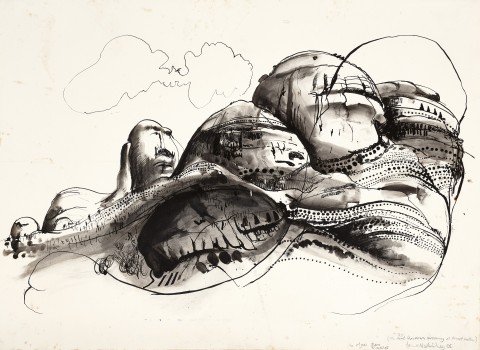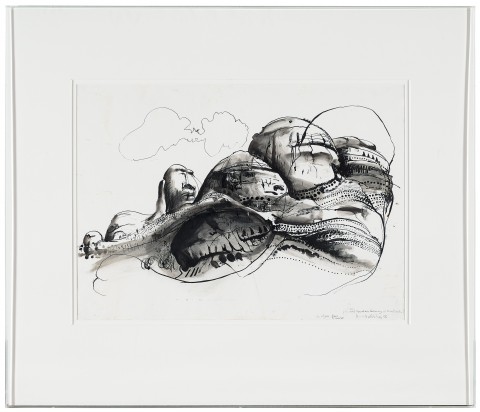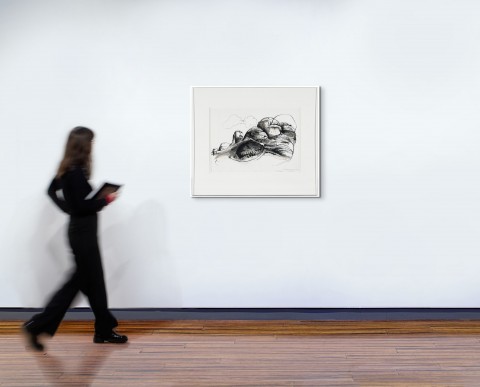THE OLGAS, 8AM, ALSO KNOWN AS OLGAS III, 1985
BRETT WHITELEY
pen, brush and ink on paper
54.0 x 74.0 cm (sheet)
signed, dated and inscribed lower right: the olgas 8 AM.. / 7/april 85 / 55 / (The arab taxi driver swooning at breast mother) / brett whiteley 85
Australian Galleries, Sydney (label attached verso)
Private collection, Sydney, acquired from the above in October 1994
162 Drawings: Brett Whiteley: 1960 – 85, Robin Gibson Gallery, Sydney, 1985, cat. 54 (illus. in exhibition catalogue, p. 36 as ‘Olgas III’)
Brett Whiteley: Drawings, Australian Galleries, Sydney, 19 September – 15 October 1994, cat. 76 (label attached verso, as ‘The Olga’s [sic.], 8 am’)
Driscoll, M. and Whiteley, B., Native Rose, Richard Griffin, New South Wales, 1986, illus., n.p.
Gray, R., ‘A Few Takes on Brett Whiteley’, Art and Australia, vol. 24, no. 2, Summer 1986, p. 222 (illus., as ‘Olgas III’)
Sutherland, K., Brett Whiteley: Catalogue Raisonné, Schwartz Publishing, Melbourne, 2020, cat. 162.85, vol. 7, pp. 666 – 667
At Dawn, Olgas III, 1985, pen, brush and black ink and ink wash on brown paper, 73.6 x 53.3 cm, private collection, New South Wales
Across Brett Whiteley’s stellar career, the landscape served as both a conceptual and very real escape from the realities of daily existence, the expectations of the art world and ever-growing success, and the largely self-created pressures he came to experience in a life fuelled by creativity and addiction. From bases in London, and later, in New York and Australia, travel throughout Europe and Africa, and extended periods in Fiji and Bali, relaxed the artist’s body and mind and charged the imagination, providing material that would populate his oeuvre for years to come. While places like Sydney’s Lavender Bay – which became the subject of some of artist’s most well-known and highly celebrated works after the Whiteleys moved there in 1970 – are clearly recognisable, more often than not the landscape is an abstracted, generalised place; an amalgam of the artist’s diverse experiences in and connection to nature. For Whiteley, the natural world and the act of making were deeply entwined: ‘Don’t just interpret nature, become its rival. Try and operatively work in the manner that rivals nature so that you do challenge God … There is sometimes that supernatural, superhuman sort of feeling when you’re creating that you are causing a world … From something that didn’t exist – here, this thing does exist.’1
Whiteley first travelled to Central Australia in the summer of 1983 with poet Michael Driscoll to create imagery for Driscoll’s forthcoming volume, Native Rose, which contained poetry and narrations inspired by Kata Tjuta (the Olgas) and the journals of 19th century explorer Ernest Giles.2 While several of the artist’s works demonstrate Whiteley’s broad interest in Aboriginal art and culture,3 this interest correlated with the sense of mysticism he similarly associated with Eastern cultures, rather than a deep understanding. While it is fair to assume that the significance of the site to the Anangu traditional owners may have escaped him at the time, Whiteley nevertheless acknowledges the traditional custodians’ presence and connection through the elegant sweep of dots that seemingly wrap Kata Tjuta’s “many heads”,4 and the liveliness of his brushwork, which conveys the “electricity” of the place and its impact upon him.
Like the female form, landscape was a site of sensuality and visual and creative pleasure for Whiteley and given his numerous depictions of the breasts, hips and curves of his wife and muse Wendy, one cannot help but see her form echoed in the sumptuous shapes of The Olgas, 8am, 1985. As Whiteley explained: ‘I know that in my work there is a certain sensuality, sexuality; there is an addiction to the curve, and to the carnal; to the rounded, I mean even to lust almost … I see sexuality, or sensuality, everywhere. I see it in clouds, and in mountains, and in fruit. And seemingly, most human motivation is caused by it – it’s a very, very deep force. And I accept it inside myself and in fact, I try as overtly as possible to allow that force to key my painting.’5
1. Brett Whiteley quoted in Featherstone, D. (dir.), Difficult pleasure: a film about Brett Whiteley, 50 mins 43 secs, Film Finance Corporation Australia Limited, 1989
2. Ernest Giles (1835 – 1897) “discovered” the soaring rock formation the Olgas in 1872 and named them after Queen Olga of Württemberg
3. These include the undated Aboriginal drawing, and the painting To Yirrawalla, 1972 (both Collection Art Gallery of New South Wales). Whiteley created To Yirrawalla as a tribute to the artist after meeting Yirawala (1903 – 1976) in Sydney in 1971 and seeing his bark paintings. https://www.artgallery.nsw.gov.au/artboards/brett-whiteley/landscape/ite..., accessed 26 June 2023
4. Kata Tjuta is Pitjantjatjara for “many heads”
5. Featherstone, op. cit.
KELLY GELLATLY


